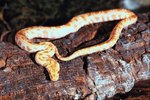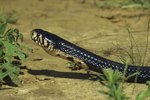
Known to inject more venom than any other snake species, gaboon vipers are among the most impressive predators on the planet. Many creatures rightly fear these adders. Gaboon vipers are apex predators; once they are adults they have no real natural enemies and no cause for worry other than humans.
Gaboon Viper Basics
Gaboon vipers are the heaviest venomous snakes in Africa, and they have the longest fangs of any species, reaching up to 2 inches. Gaboon vipers are incredibly patient ambush hunters who lie on the forest floor, partially covered by leaves, while they wait for food to walk by. When the gaboon vipers strike prey, they often hold on, waiting for the venom to take effect, rather than letting go like many other venomous snakes do. A single bite may inject up to 600 milligrams of venom -- and it takes only 1 to 12 milligrams to kill a mouse. Remarkably camouflaged, gaboon vipers are hard to see against the forest floor. One of the most comprehensive studies of the species was a dissertation by researcher Johnathan Kirk Warner of the University of Witwatersrand in Johannesburg, South Africa. In the paper, Warner detailed several occasions when he or his dog actually stepped on a gaboon viper without seeing the snake – a perfect illustration of the snakes’ cryptic abilities.
Predators
Unsurprisingly, adult gaboon vipers have no known predators. Even some of Africa’s most notorious snake eaters, the monitor lizards (Varanus sp.), which may be immune to many snake venoms, don’t want 2-inch-deep puncture wounds. The paucity of adult gaboon viper predators may have a root in fear; gaboon vipers eat extremely large prey -- sometimes approaching their own body mass -- and many medium-size carnivores could end up as food for the snake. Juveniles are eaten by secretary birds (Sagittarius serpentarius), large monitors (Varanus sp.), fish, cats and cobras (Naja sp.). Warner’s study mentions one juvenile that was eaten, but he does not note what the predator was.
Trampling
Given their incredible camouflage, Warner asserts that one of the greatest threats to gaboon vipers is being trampled by large ungulates, elephants or hippopotamuses. This threat is greatest in the winter, when the gaboon vipers move into more open habitats to absorb more solar radiation. During this time, the snakes spend a lot of time in clumps of dense vegetation, which likely protects them from being trodden upon.
Humans
Humans kill snakes out of fear, sport or persecution otherwise; some indigenous groups hunt them for meat. Though gaboon vipers have evolved a suite of defenses that render them virtually untouchable in their historic habitat, the snakes have no defenses against determined humans. By virtue of tools like rakes, shovels, guns and axes, humans can kill the snakes from a safe distance. Fortunately for the gaboon vipers, they prefer undisturbed, primary forest habitats and aren’t often found in close proximity to civilization. In addition to direct persecution by humans, human-caused habitat destruction threatens gaboon vipers as well. Gaboon vipers depend on undisturbed forest habitat and cannot thrive in suburban or disturbed areas like some other snakes, such as the closely related puff adders (Bitis arietans).
References
Photo Credits
-
Jupiterimages/Photos.com/Getty Images



